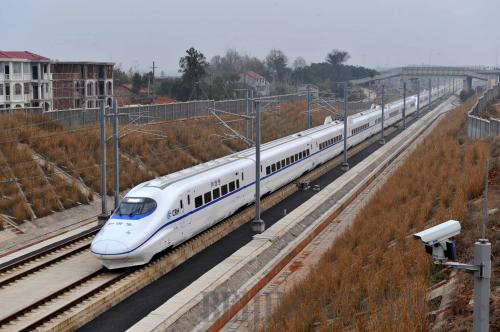|
 |
|
NEXT GENERATION: The Wuhan-Guangzhou passenger dedicated line, China's first long-distance high-speed railway, begins operating on December 26, 2009 (DU JUHUA) |
The launch of China's longest high-speed railroad between the two major cities of Wuhan and Guangzhou will likely increase competition among the country's mass-transit carriers.
The 1,069-km-long Wuhan-Guangzhou passenger dedicated line, China's first long-distance high-speed railway, began operations on December 26, 2009. The train shortens travel time from Wuhan, central China's Hubei Province, to Guangzhou, south China's Guangdong Province, from 10 hours to just three. The new railway is serviced by the world's fastest trains, which travel at a speed of 350 km per hour.
"The successful operation of the high-speed railway of more than 1,000 km will help demonstrate China's technological strength and appeal to countries like Russia, India and the United States, which also have broad territories and plans for building high-speed railways," said Yang Hao, a railway transport professor with Beijing Jiaotong University.
The new line requires more complicated train technologies than China's first 120-km-long high-speed railway between Beijing and Tianjin, which began operating on August 1, 2008.
Two models of trains are being used on the line, each consisting of two eight-car electric multiple units coupled together to make a 16-car train. The train can accommodate 1,200 passengers.
With the opening of the line come new opportunities throughout the area it covers. It will help to form a more vibrant economic circle around the three dynamic areas of Guangdong, Hunan and Hubei provinces, all of which are now linked together by the railway.
Economists estimate that the railway line will help the economic transformation of the Pearl River Delta region, a major manufacturing center of China, from labor-intensive to capital-intensive, and create an industrial base with a value of hundreds of billions of yuan.
Transportation competition
By cutting travel time by such a large amount and offering better services, the railway also poses a real threat to airlines running flights between the cities. Train passengers enjoy more space and facilities. Also, train crewmembers are required to speak Chinese and English.
"The high-speed railway has three advantages over air travel: it is more convenient, more punctual and has a better safety record. This could help erode the airlines' market share," said Si Xianmin, Chairman of China Southern Airlines, the largest domestic airline by fleet size.
Thirty-eight of China Southern's more than 160 domestic routes will compete with the railway. The airline has a hub in Guangzhou and has aggressively cut fares, slashing the advance purchase price of flights between Wuhan and Guangzhou by almost half. To help ensure on-time arrivals, the airline also signed a deal with Wuhan and Changsha airports to give priority to flights to Guangzhou.
But the two forms of transit could also learn to coexist. "In the long run, the coming of the high-speed railway is an opportunity rather than a challenge to our airline company," said Tan Wangeng, President of China Southern Airlines. "China Southern is expecting to cooperate with the railway company to extend the market and develop more packaged travel products for passengers."
"Comprehensive planning should be made to give full play to road, railway and airline transit and to avoid overlapping construction and wasted resources," said Xu Guangjian, a public management professor at Renmin University of China.
Wu Wenhua, a researcher with the National Development and Reform Commission's Comprehensive Transport Institute, said developing high-speed rail networks is in line with the demand for high-efficiency, low-emissions transport.
The Wuhan-Guangzhou line is just part of a farther-reaching, high-speed network in the works in China. In the next two years, railways linking Beijing and Shanghai, and others connecting Shanghai with Wuhan, Sichuan Province's Chengdu and Yunnan Province's Kunming will be built. Their completion will usher in a high-speed era. The country plans to have high-speed rail services running between 70 percent of key cities by 2020, which would cover more than 80 percent of the domestic airline network.
About 16,000 km of railway will be built on the mainland in the next 10 years for trains that can run at 350 km per hour, according to a plan by the Ministry of Railways. By 2012, work will be completed on 42 high-speed links covering 13,000 km, the plan showed. | 